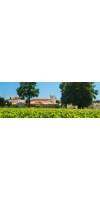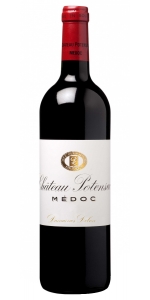Wine from Potensac

The estate has been in the same family since time immemorial and has always been handed down by women. The current owner, Jean-Hubert Delon, inherited the estate from his paternal grandmother, Georgette Liquard. Although close to the river, Potensac is situated on a high point of land in North Medoc. Because of this position, the site has been populated since ancient times. The name "Medoc" in fact comes from "medio aquae" which means "in the middle of the waters"…
Planted on the best quality soils in the Ordonnac district, the vineyards now extend over 60 hectares on a terroir where the typical characteristics of each grape variety express themselves very distinctly and give the wine superb ageing potential.
The vineyards spread mainly over hilly mounds with a limestone subsoil covered with clay and gravel outcrops containing a high proportion of gravel ("graves"). These limestone soils are very similar to those found in the Saint-Estèphe appellation. On this very special terroir, some plots of Cabernet Sauvignon and Cabernet Franc planted over 80 years ago still produce perfectly ripe, healthy grapes. The hamlet of Potensac was already cited in the first edition of Féret for the special characteristics and longevity of its wines.
Potensac Medoc is made from 44% Merlot, 33% Cabernet Sauvignon, 22% Cabernet Franc and 1% Petit Verdot.
The estate's Grand Vin's vineyards are located west of the village of Ordonnac where the vines grow on gravelly-clay soiils. They produce a very fine wine with tight texture, richness and wonderful freshness. On the palate, the wine is pure and powerful, with great concentration, dense and spicy tannins, and mineral tension. Fresh and full-flavored with ripe black fruits, and a finish of great depth. Thanks to these qualities, Château Potensac is often considered to represent the "pure Medoc style". It should be noted that Potensac was the only "Cru Bourgeois Exceptionnel" of its appellation, and certainly one of the most persistent ever produced at this stage.
- back
Selected Options
Wineries
Categories
Pricing
Countries
Regions
Grape Types
Wineries
Organic/Free Shipping
Chateau La Nerthe Chateauneuf-du-Pape Rouge is made from Grenache 39%, Mourvédre 33%, Syrah 25%, Cinsault 2%, Others 1%.
Château La Nerthe is one of the oldest estates in Châteauneuf-du-Pape and dates from 1560. Château La Nerthe has 227 acres of vineyards that surround the château and top the renowned La Crau plateau. The terroir is typical of the region. Vineyards run along a slope and grow in sandy-clay soils. The ground is covered by a layer of ‘galets’ – large, round, well-worn stones that were carried down from the Alps by glaciers during the last ice age. All the 13 permitted primary varietals are planted here. Grenache dominates 62% of the vineyards and the average vine age is over 40 years old. The grapes are hand harvested and sorted on tables. The grapes are then put into vats for almost 4 weeks with regular pump overs and punch downs. The must is tasted every day during fermentation to ensure the best extraction of the berry compounds. At the end, the wines are racked into oak vats for malolactic fermentation. The cuvée is then aged in large French oak casks and barrels for 12 months before blending. Bottling takes place 6 months later.
The dark, deep, inky color of the wine shows immediately, stemming from the concentration of the vintage. Nose of blackcurrants, black tea and dried flowers stands out. The mouth is rich, fruity and velvety with an incredibly layered tannic structure. The wine is balanced and pure with strong intense and incredibly long aging potential.
- One of the oldest estates in Châteauneuf-du-Pape - dates from 1560
- Estate grown, hand harvested, estate bottled
- Average vine age is 40+ years
- Certified AB Organic
Review:
A focused expression, this wine delivers pure red and black fruits unfolding against a delicate rose-petal backdrop. Silky yet chewy tannins gradually reveal layers of red cherry, pomegranate, spice, violets, and a hint of clove. Its elegance is underscored by fine tannins, suggesting a wine that, while quiet now, holds the promise of revealing its full beauty with time in the bottle. Cellaring through 2028+ before revisiting should prove to be rewarding.
-Wine Enthusiast 93 Points





